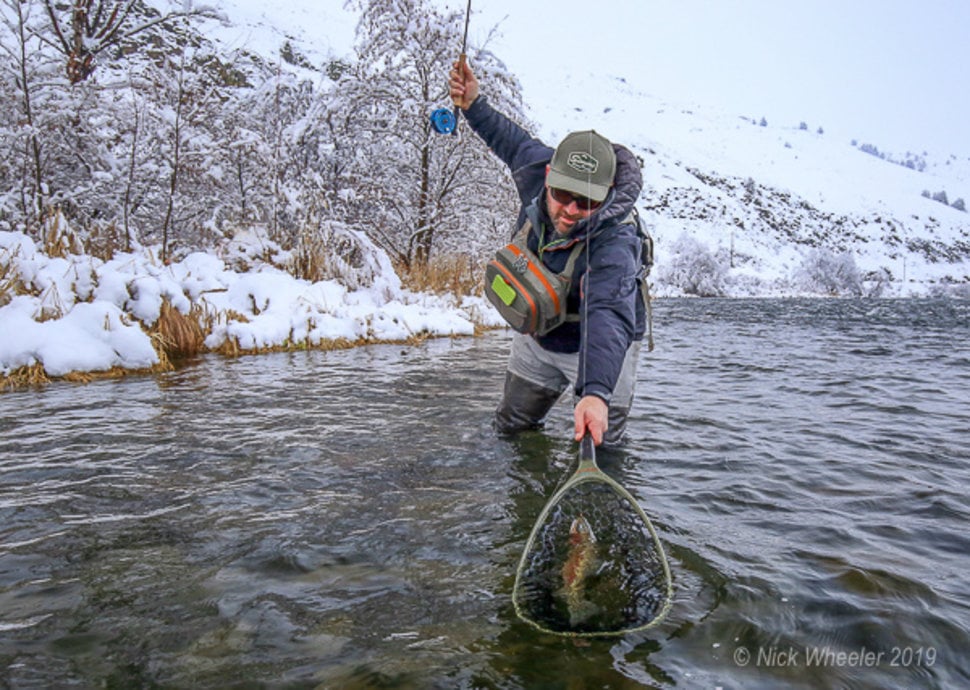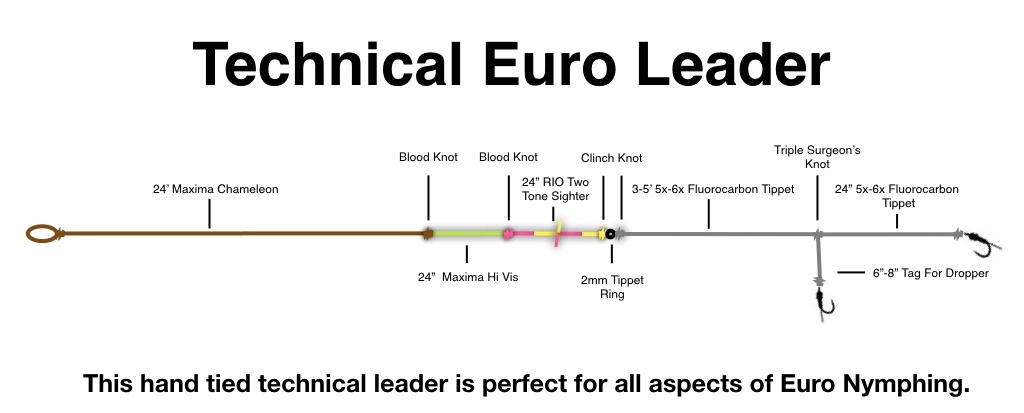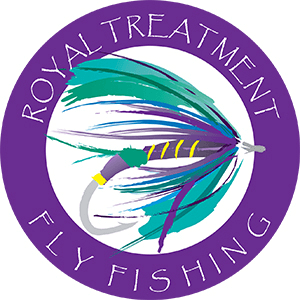Euro Nymph Leader formula 1,000,001

There are a million Euro Nymph leader recipes on the internet, now there’s a million and one.
We get a lot of questions about Euro Nymphing and the tackle and techniques that we use. So it seemed like a great idea to give to a little insight into the leader used for this technique. Now, this isn’t the end-all do-all for Euro Nymphing, this is just one option. If you have Googled Euro Leader recipes there are about a million leader formulas and this is just one more. Like all things, take it with a grain of salt and understand this is purpose-driven. We are most often fishing the Deschutes and the Metolius where we are trying to fish in close but also far away. Also, because we aren’t competition fishing we don’t have restrictions that dictate how long the leader can be.
Before we take this deep dive into the Euro Leader we should probably define a couple of terms so we are all on the same page.
-When we refer to the leader we are talking about the part from the fly line to the tippet ring.
-From the tippet ring to the flies is the tippet
-Sighter is a hi-vis multi-colored leader material that we use as a visual cue to help us understand what the flies are doing. We are most often referring to RIO’s two-tone indicator that alternates colors every 6 inches.
-tippet rings are small stainless rings that are used for attaching tippet material
We have tried a lot of different leader formulas around here and they all work. Whenever you do, or use, or test, or try something there’s always going to be a benefit/deficit. We have found that the heavily tapered formula or even the leaders that incorporate a tapered leader cast better, more like a fly line, so that’s a benefit. Unfortunately, we have noticed a few deficits, it doesn’t cast as far and the heavier leader doesn’t allow you to hold it off the water without it sagging and dragging back to you. So to counter these deficits we are using a very thin leader, typically 6lb or 8lb maxima. The thinner leader may not cast like a fly line but it will cast far with reduced drag. Also, because the leader is thinner and lighter you can easily hold a lot more of it off the water without the sag and drag. If you Spey cast you are probably familiar with what I speak of. When you are trying to hold a fly line type shooting line out of the water you move that it is heavy, it says, and drags the head into you. The thin mono shooting line stays tight when you are holding it out of the water and has a direct connection to the head. While this is not a Spey outfit we are trying to accomplish some of the same things. We want the flies to stay put and be able to hold that leader out of the water and maintain a direct connection to those flies. The other big difference is that we are fishing what seems to be a crazy long leader. In this formula the leader is 28’ long, typically we are fishing a leader that’s even longer around 40’. The extra length enables us to cast further and so we can fish at a greater distance and still hold all of the leader off of the water. The ultralight leader that we so often are using isn’t a great delicate casting leader but it has a very tactile feel while fishing. Because you can keep the flies under tension you notice everything that is happening. If the flies touch a rock or a fish touches the flies it’s very discernible.

The leader has three sections.
The butt section is made of a section of Maxima Chameleon. We typically use between 24’-36’ of 8lb. If you are reluctant to use such a long leader you can use as little as 12’ but we recommended starting with 24’. On one end we put a small perfection loop to attach to our fly line.
At the other end of the long piece of Chameleon we blood knot a 24” section of Hi-Vis maxima. We typically use the same or lighter than what we had in the butt section. That helps us maintain that light feeling and enables us to hold the line off of the water. We add the short section of HI-Vis so that when we are lifting our leader off of the water it will be our first visual cue that we have the leader almost all of the way off of the water.
To the end of the section of Hi-Vis we blood knot on a 24” piece of sighter material. Again we want to use the same size or smaller to continue the taper and keep that tactile feel. The thinner the material the harder it is to see, but the better it will fish. I like to take the 24” sighter and cut it at the junction in the middle and re-tie it with a blood know leaving two short tags. Those two tags are going to be the second visual cue that I am almost at the end and to slow my lift. Often time if I omit the tags I will lift the whole thing out of the water. The two tags in the middle also help me to find the sighter and leader when I am fishing in difficult light situations.
At the end of the Sighter I am going to attach a tippet ring. This is our basic leader formula.
For the tippet we suggest using fluorocarbon tippet, 5x is a good starting point. The thinner tippet sinks faster and is more invisible. The tippet section consists of two pieces of tippet tied together with a triple surgeons knot. The first section of tippet is blood knotted to the tippet ring and is usually between 3’-5’. We adjust the length of tippet depending on the river we are fishing or how deep we are trying to get. On the lower part of the Metolius, we typically fish a longer top tippet section around 5’. On the Deschutes, we are often fishing a piece that is 4’ long. And on the Crooked, we are fishing around 3’. Use a triple surgeon’s knot to attach the second piece of tippet approximately 26” long for your point fly. We have noticed with the longer spacing between flies you end up getting more doubles, literally a fish hooked on each fly. After we connect the two pieces of tippet we leave the tag that is facing down around 6”-8” long so we can attach our dropper fly. We trim the tag that is pointing up the leader system. The heavier point fly goes on the bottom, and the lighter dropper fly goes on the 6” tag up above.
Leader building supplies
I hope this helps give a snapshot of what we are doing. Again this is not set in stone and probably will change but this is a great jump-off point that will help you fish this exciting effective technique. If you have questions feel free to send an email, give us a call, or stop by the shop.




